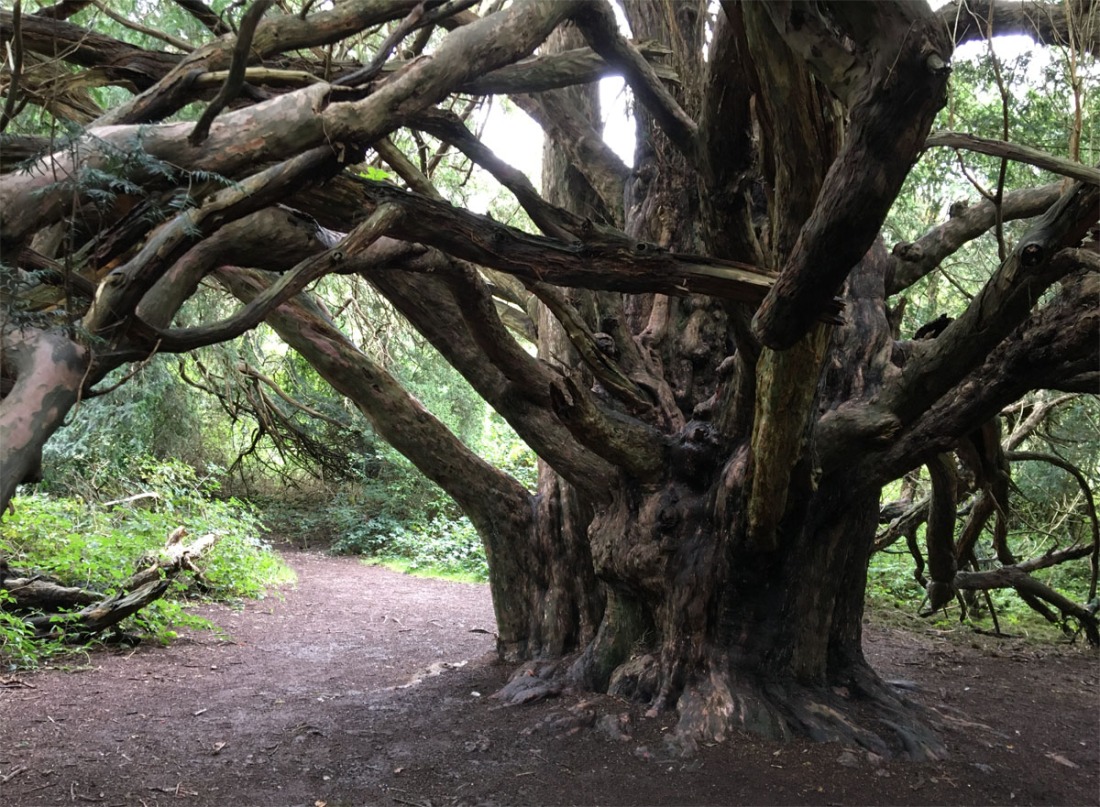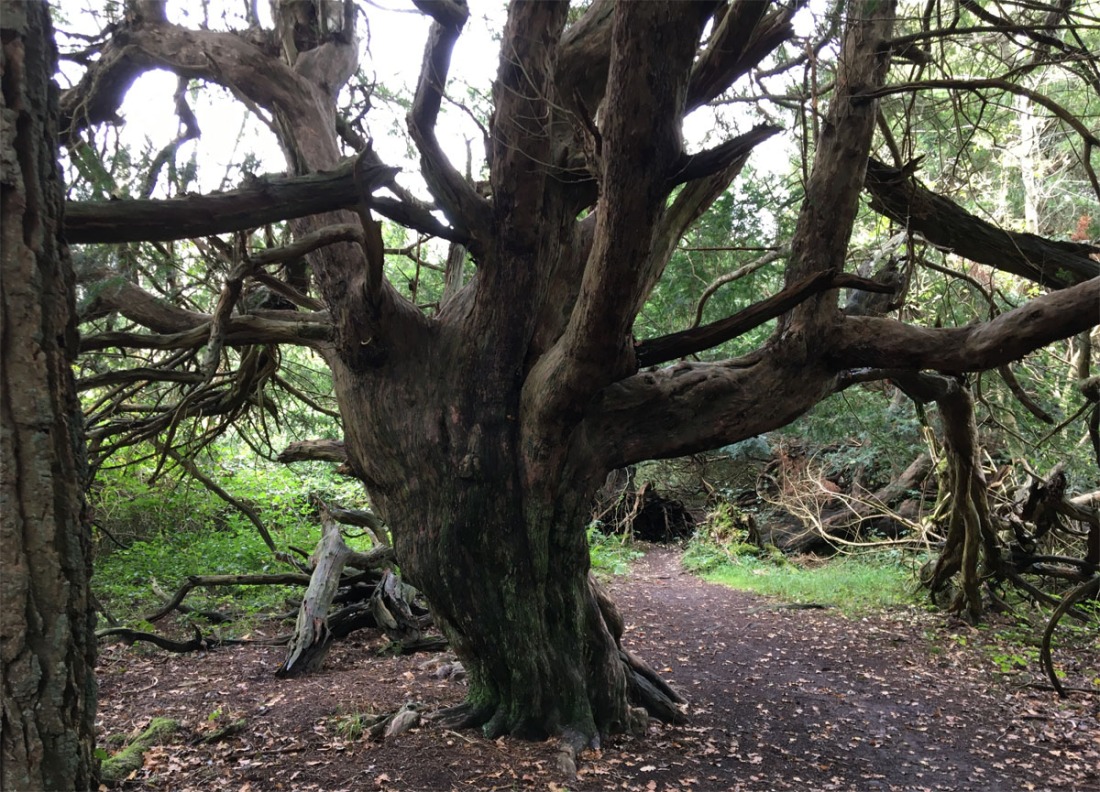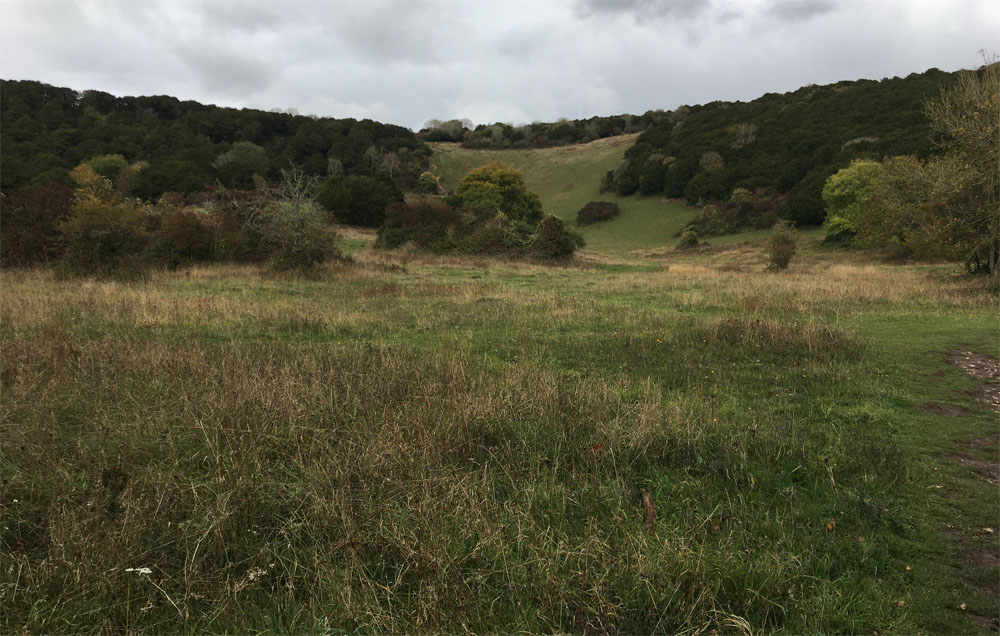What would they say to us and our hasty lives?

No one knows how old the yews of Kingley Vale National Nature Reserve might be. Local legend says that they were planted after a battle with the Vikings in the 9th century; other estimates vary from 500 years to 2,000. In country where most ancient yews haunt churchyards as solitary wardens, in a continent where the 15th century craze for longbows drove a insatiable demand for yew-wood, a grove like this is exceptional.

Age adds to the atmosphere of tangled boughs and trunks that bulge and burst into impossible shapes, like a clay pot being worked on a very slow wheel.

The yew has special significant to us; people have been building with its wood since the Palaeolithic. Their presence in churchyards may date to the bubonic plague – they were allegedly planted on the graves of victims to purify them. It is also said that they were a deterrent to locals looking for a place to graze cattle; their extremely toxic fruit is deadly to livestock and to much else.
Birds get by with the yew, however, swallowing the fresh and excreting the stone. Their dense structure gives protection to small species like goldcrests. But a yew grove can be silent, still, a place where thoughts grow and are left to hang in the air.

Beyond the yews, Kingley Vale opens into chalk downland.

A riot of colour in the summer, but the flowers are sleeping now. They will return.
The yews have seen it all before.
What beautiful old yews! We have only very young ones. And they won`t get very old, probably, in a suburb of Munich.
LikeLiked by 1 person
Is it a tradition in Germany to have yews in churchyards like it is in the UK? Interestingly, some of our yews benefit from another rare tree – the juniper – as a ‘nurse plant’. The juniper has sharp spines and if it is close to the yew sapling, this deters grazing animals.
LikeLike
Adele,
Another awesome account of the ancient yew tree… thanks
Do you know the ginkgo tree… it’s a fav of mine
LikeLiked by 1 person
Thanks Tony. Gingko is a fabulous tree but I don’t think that I’ve never ‘met’ one in person so to speak. I will have a look next time I’m at an arboretum.
LikeLike
Yew’ve made an excellent post about these trees. Very impressive photos of these old, old, super-old trees.
LikeLiked by 1 person
The stories they could tell! Very glad that they’re safe in a national nature reserve (which is best described as what the rest of the world calls a ‘national park’).
LikeLiked by 1 person
It would be a crime if they ended up as firewood. It probably is a crime in the literal sense of the word.
LikeLiked by 1 person
In the nature reserve, certainly. Wildlife and plants in the non-protected parts of England and Wales (Scotland has its own laws) are protected by various bits of legislation, some of which are very good, and others have holes. I might do a post on the laws and conservation designations of England because it’s confusing enough even to most English people.
LikeLiked by 1 person
These trees are so impressive. In BC we gave the Pacific yew, which is apparently a close relative. It has been exploited for drug companies (the bark is used in anti-cancer treatments) and is now endangered and protected. I’m not sure whether drug companies have turned to an artificial form for cancer therapies.
Beautiful photos.
LikeLiked by 1 person
Thanks Lynette. Hopefully a synthetic form of the drugs has now been produced.
LikeLiked by 1 person
It’s hard to fathom a tree growing so old. Venerable!
LikeLiked by 1 person
Some of these probably had English wolves and bears resting at their feet when they were saplings! They are very special links to the past.
LikeLiked by 1 person
I admit I had to look in Wikipedia to figure out which tree you are talking about. It is common in Serbia (we call it tisa, pronounced as tee-sa) and in eastern Canada.
I have a soft spot for old trees. I don’t like to see photographs of huge trees being cut 100-120 years ago in western Canada and USA. What a world it was before! And now old growth needs to be protected from disappearing.
LikeLiked by 1 person
Sorry, I should probably have put the latin name on there! Out of interest, how is juniper (Juniperus communis) doing in Serbia? It’s a species of conservation concern here for a number of reasons but I understand that a lot of berries are exported from the Balkans.
Old growth does need to be protected, and so old meadows, but too many people still haven’t learned.
LikeLike
Juniperus communis (we call it smreka or kleka) is growing in southern Serbia and as far as I know it is not endangered. But not too common, as well. I think more of it could be found in Bosnia and a little bit in Croatia and Slovenia. Parts of the tree (needles and fruits) are harvested for its medicinal purposes. Now, when I was searching for juniper I got some mixed results on Google, pointing toward spruce as well. Are they similar, from the same family? There is an interesting sort of spruce called Panciceva omorika (Picea omorika) named after famous Serbian botanist Josif Pancic.
LikeLiked by 2 people
That is interesting – that spruce is a new one for me. Wikipedia suggests that it had a wider range before the last ice age so perhaps it was found in England once? It does look superficially like juniper but they are in different families.
LikeLiked by 1 person
Another wonderful post, Adele!
LikeLiked by 1 person
Thank you Belinda!
LikeLiked by 1 person
Adele, what amazing old trees! A fairy tale grove if there ever was!
LikeLiked by 1 person
Yes, it was like something out of The Lord in the Rings!
LikeLike
As we age our faces develop character, lines from smiling or pain, wrinkles where we were once smoth. So with old trees. Their shapes challenge the imagination to guess at what caused the tangles and seeming contortions they now show. These yews are gorgeous in their mishapenness. Of course they remind us of Ents and no doubt hold the wisdom of ages. Thanks for sharing this wondrous grove, Adele.
LikeLiked by 2 people
Thank you Steve and yes, every line and twist of these yews must have an ancient story. I too thought of Ents. I don’t know if Tolkien ever visited Kingley Vale, but surely he would have been intrigued by it.
LikeLiked by 1 person